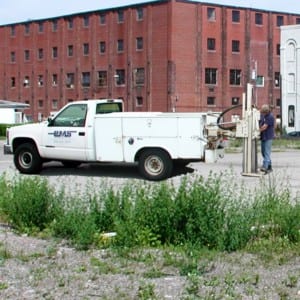Cost of a Phase II Environmental Site Assessment
 Are you curious about the typical Phase II Environmental Site Assessment cost (also referred to as a Site Characterization Report, Environmental Site Investigation, or Remedial Investigation depending upon the nomenclature used by the applicable regulatory agency)? You’ve come to the right place. Here we will explore the variants that can cause price fluctuations, so that you can be sure you are receiving the best service for the best price.
Are you curious about the typical Phase II Environmental Site Assessment cost (also referred to as a Site Characterization Report, Environmental Site Investigation, or Remedial Investigation depending upon the nomenclature used by the applicable regulatory agency)? You’ve come to the right place. Here we will explore the variants that can cause price fluctuations, so that you can be sure you are receiving the best service for the best price.
There may be slight variations in the procedures or requirements for the different environmental assessment titles listed above. However, they all have three primary goals in common:
- Determine if the soil or groundwater beneath a property is contaminated.
- Determine the type and concentration of the contamination
- Determine the extent of contamination
So what exactly drives the cost of an environmental site assessment? Well, it depends. Different regulatory agencies have different requirements, property owner/purchasers have different requirements, and there are different requirements for different types of spills. However, there are some things in common with all environmental assessments. They can vary widely in cost.
Factors that may influence the final Phase II Environmental Site Assessment cost:
Underground Utility Mark Outs
Site investigations typically include installation of soil borings and monitoring wells to determine soil and groundwater quality. Almost all drilling contractors call DigSafe or a related organization for an underground utility mark out. The utilities (water, sewer, gas, electric, and telephone) will mark the location of their underground lines that are located in the public right of way. However, they do not mark out utilities on private property. Many, many times we have seen underground utilities that were damaged during drilling because of wrong as-built drawings, unknown easements, and unknown utilities. Repair to these utilities can be very, very expensive.
Rather than blindly poking around and running the risk of damaging underground utilities, Ambipar Response EMS uses a tool called an air knife. This tool uses air and vacuum to carefully excavate up to six feet into the ground to pre-clear a hole thus mitigating the risk of drilling into an expensive line. This process might cost a little extra, but it can also save thousands.
Soil Samples
Soil samples are collected to characterize the extent of contamination adhered to soil particles. The issue becomes how many samples to collect and from where to collect them. During the initial site characterization, EMS uses a tool called a Photo Ionization Detector (PID) to conduct a screening of the organic vapors emanating from samples from the entire column. For each boring, the soil sample with the highest PID reading is sent to a laboratory for analysis.
Installation of Monitoring Wells
Monitoring wells are installed to determine the direction of groundwater flow and to determine groundwater quality. Many factors influence the cost of the wells:
Depth of Wells
Your cost will depend upon the depth of the wells. In some cases, a well will only need to be drilled 10 feet before reaching water. In other cases, the well may have to be drilled 100 feet before reaching water. Depending upon the nature of the spilled material, the well depth may also have to be deeper.
Composition of Subsurface
Drilling through sand is easier, and requires simpler technologies. When drilling a shallow well through sand or a similar soil, we may be able to use a technology which punches a shallow hole through the surface. If we are drilling through rock, a more complex and expensive technology is necessary.
Type of Site
Different sites may have different access issues. Certain types of drill rigs may not be able to access particular areas if there are topographical and/or structural access obstacles. There are different costs associated with different types of drill rigs and technologies.
Number of Wells
The number of wells that need to be drilled depends on how far the contaminants have traveled. If the spill is contained to a relatively small area, only three or four wells may be needed to define the area of contamination. Conversely, if the contaminants have spread over a large area, many monitoring wells may be required.
Water Samples
Water samples will be collected from each monitoring well and submitted to a laboratory for analysis. The nature of the spilled material and the requirements of the controlling regulatory agency will dictate the required analytical methods. In Pennsylvania, we only look for seven or eight components as compared to North Carolina, where we can test for nearly 40 or 50 components. More components will cost more money.
Report
The end product of an Environmental Site Investigation is the final report that is submitted to the regulatory agency. The content requirements for the report are specific to the nature of the contaminant that was spilled at the site and to the requirements of the state or federal environmental agency that is providing oversight of the work.
At Ambipar Response EMS, Inc., we’ve seen costs as low as $6,000 for a complete Phase II Environmental Site Assessment. However, the average cost for a Phase II Environmental Site Assessment hovers around $15,000, but no two sites are the same.
Extensive contamination that occurs in a highly sensitive area may require much more investigation than a small spill in a non-sensitive area. Fluctuations in final price depend upon each soil and water sample, the extent of drilling, the method used to conduct the investigation, and the preparation of the site characterization report.
Please feel free to contact us with any questions you may have regarding Phase II ESAs!

You can find more information about Phase II ESAs in these articles:
What is a Phase II Environmental Site Assessment?
Why Property Sellers Should Conduct Phase II Environmental Site Assessments


